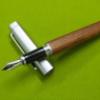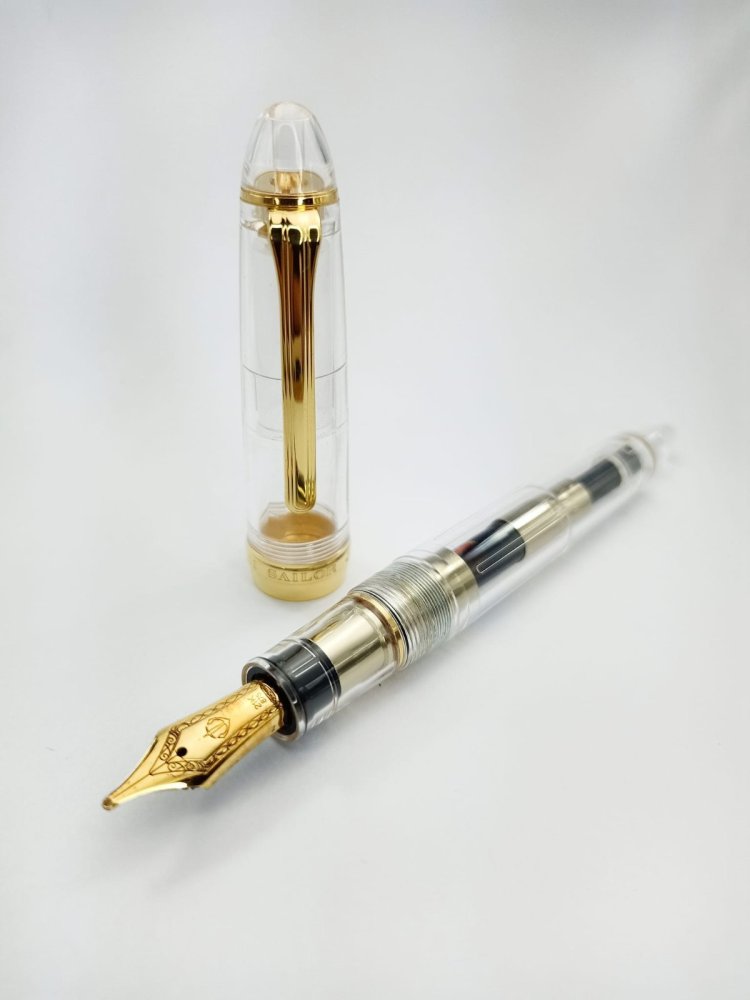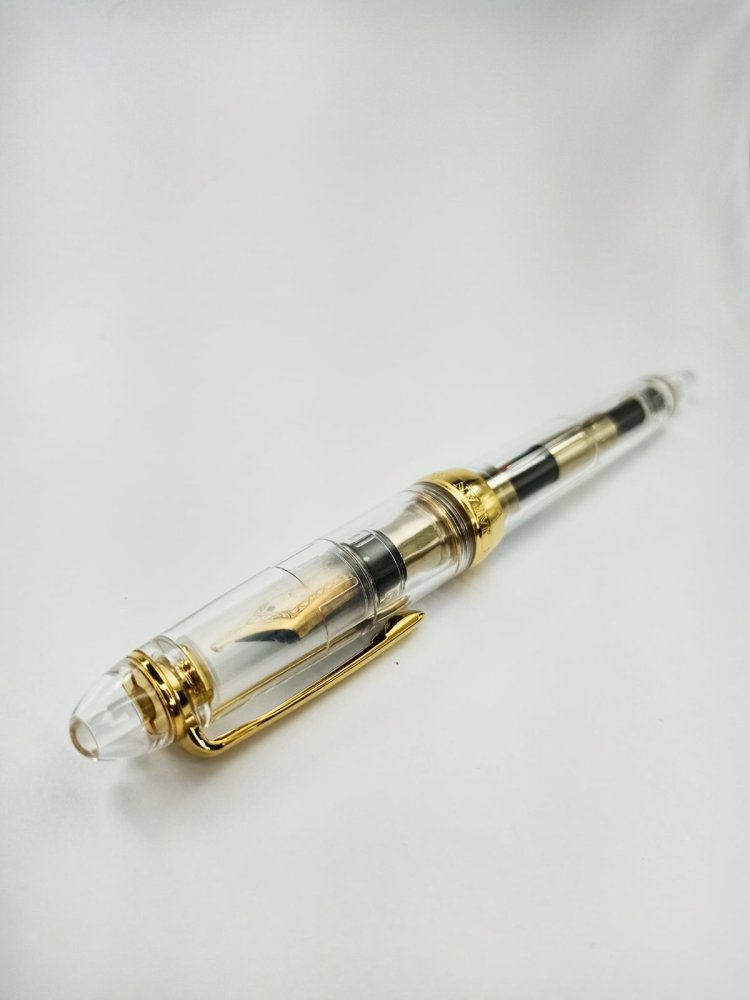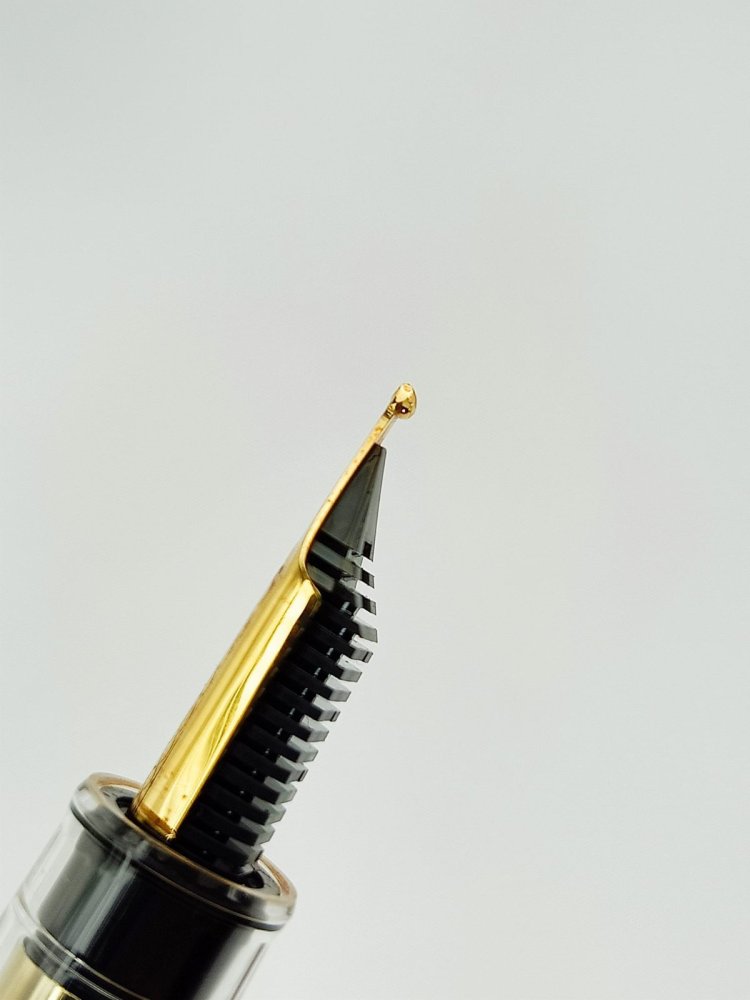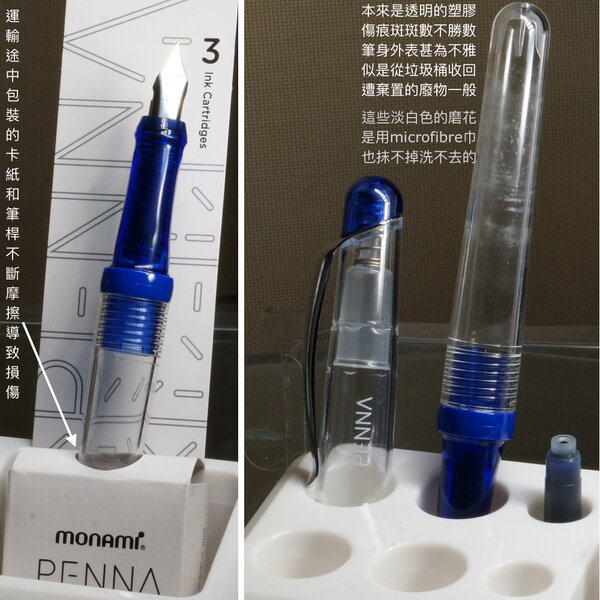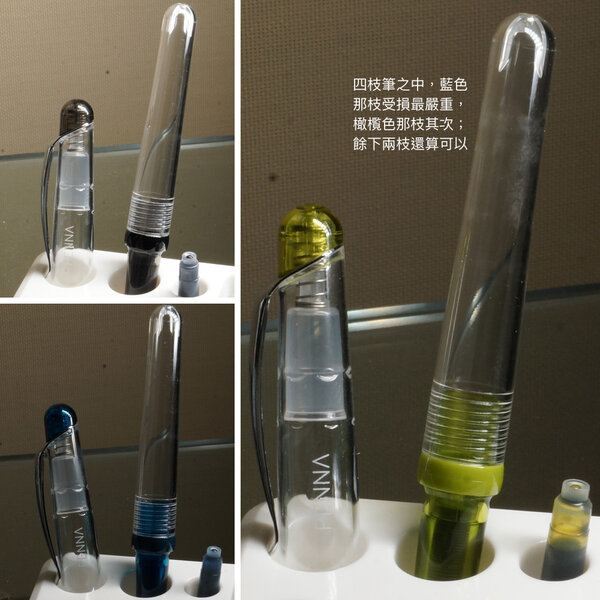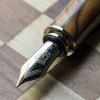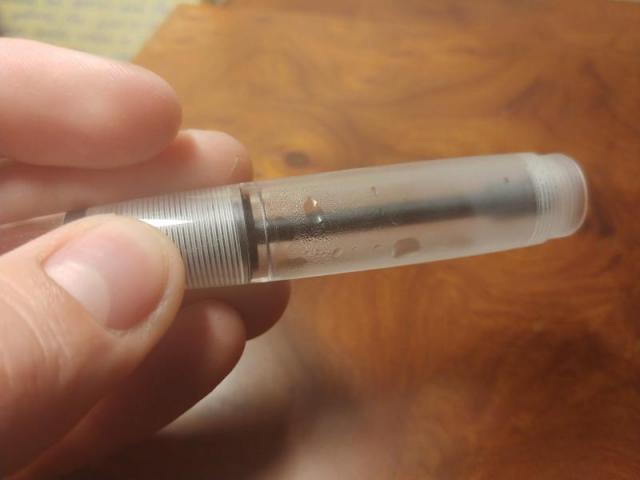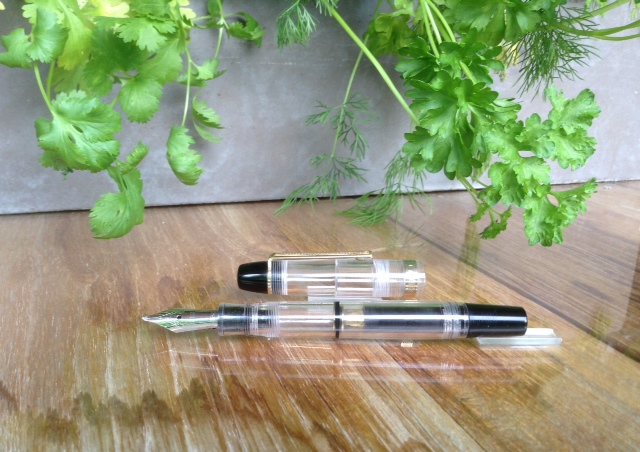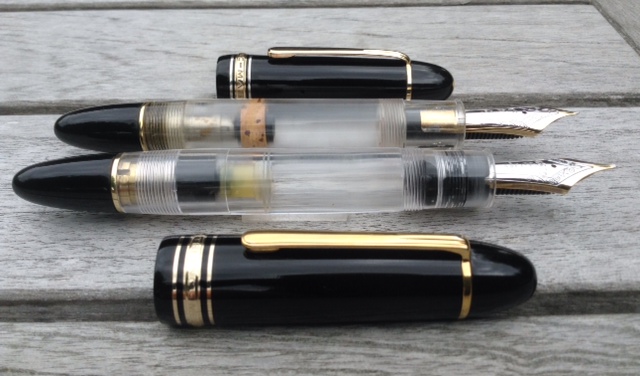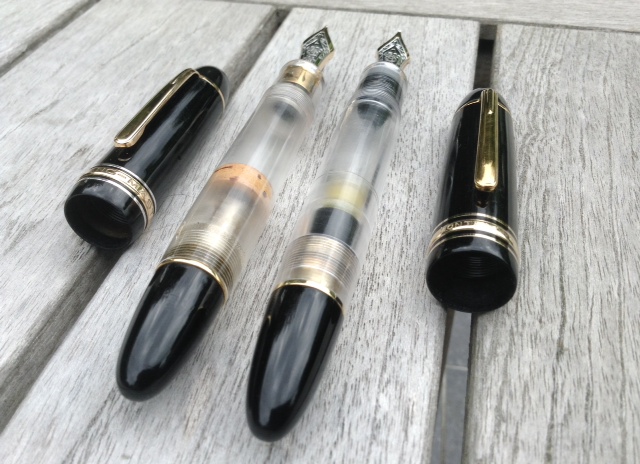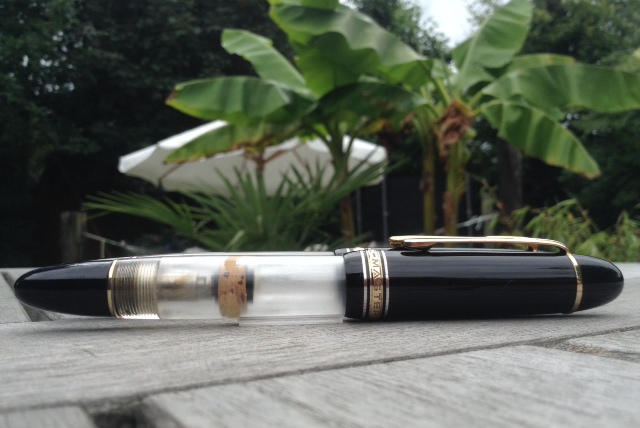Search the Community
Showing results for tags 'demonstrator'.
-
From the album: Mercian’s pens
This (bad) photo shows my current 'fleet' of 'demonstrator' pens. L→R they are: Lamy Vista (my first Lamy pen, and one that I have had for long enough that I have almost entirely worn-off the sticker on the end of its barrel that said 'LAMY'); Pilot Prera Iro-Ai green, with 'EF' nib; Pilot Prera Iro-Ai black, with 'F' nib; Pilot Prera Iro-Ai red, with 'M' nib; an un-branded Chinese-made pen. That last pen has a folded steel nib with no indicated nib grade. I bought it a few years ago - with two included cartridges - for 'fully' £0.59 in a bricks-&-mortar shop here called 'Home Bargains'. You can see that its clip is broken (its only utility is as a roll-stop. Cf the clip on my Pelikan P480 Pelikano). It wrote perfectly acceptably with the first of its included cartridges. At this price, I was frankly surprised that it even wrote at all. It is rather small for my paw, so I have not yet used its second cartridge of (unbranded) black ink.© Mercian
- 0 B
- x
-
- lamy vista
- home bargains 59p pen
- (and 3 more)
-

ASVINE V126 Plunger-Filler Demonstrator Fountain Pen Review
donnweinberg posted a topic in China, Korea and Others (Far East, Asia)
I have been testing a new Asvine V126 Plunger-Filler demonstrator fountain pen that I purchased from an Ebay seller in China. Here are some photos: Here are my early impressions: I used the plunger filler mechanism to fill the pen with blue-black ink. A single push inward drew up only about one-third of the capacity of the mechanism. I did not try multiple plunges at that point, as I was curious how much a single plunge would draw in and did not want to waste ink just to test the pen as a writer. The pen feels great in the hand. It weighs 28g with the ink at 1/3 capacity. The cap itself contributes 9g to that total. The cap can be posted securely at the end of the barrel. The nib is a gold-plated medium steel nib and has a bit of give, which makes the writing experience aesthetically pleasing. The pen wrote immediately and smoothly, and over the days it continues to do the same, with no hard-starts. The acrylic of the body and cap feels to be of high quality and durability. The clip is firm but has enough natural give easily to fit into a pocket. So far, so good. I really like this pen, which is a pleasant writer. I'd be interested in the experiences of others who have used this pen or its equivalent (i.e., non-demonstrator). In particular, what has been your experience with how much ink gets drawn into the pen with the plunger-filler?- 10 replies
-
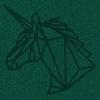
Dollar 717I - The Most Underrated Pen Ever? Written Review + Bonus Pictures
Sui-Generis posted a topic in Fountain Pen Reviews
- 18 replies
-
- review
- piston filler
-
(and 2 more)
Tagged with:
-
(filled with Rohrer & Klingner Alt Bordeaux) Demonstrators are not really my area. I do somewhat appreciate them as a sort of curiosity, but I prefer more traditional finishes and colors. That being said, a piston filling demonstrator does seem like an interesting idea, and since I've never had one and lately it became possible to buy them for less than $20, I thought I'd try one. I already had the solid black Wing Sung 698 so I wanted something different (and while I do like WS 698, I'm not that crazy about its design). So, Caliarts Ego II it is. To be precise, I ordered the first Caliarts Ego, which had a very different clip and an opaque black piston mechanism, but ended up receiving the second version. Deciding that it's not worth to make a fuss about it, I accepted what I got. Caliarts Ego II is a clear demonstrator, and when I say clear, I mean totally. The only elements of it which are not transparent are the nib and the clip. I do like the design of this pen, much more than Wing Sung 698's. It's just more neat, better shaped and the clip is much better looking. For the record, Ego II also comes with the piston knob and the cap finial opaque in a few colors (those seems out of stock on eBay now) and one fully solid color in a very bright blue. The pen came in a steel box, packed with a little wrench for disassembling and a spare feed and EF nib, while the one on the pen is marked as F. Both nibs are stamped "Caliarts Iridium Point". I think those are Pilot 78G/Metropolitan/Plumix etc. compatible nibs but I haven't tried any swapping. The wrench quickly proved useful. At first glance I noticed that the piston didn't come all the way up as it should. So I took the wrench, and not really knowing what I was doing I tried to twist the piston. There was some noise, for a second I thought something cracked, but no, surprisingly the piston went up to the exact position I wanted it to be. Now, however, it doesn't come all the way down. The piston seems to be too short to fully utilize the pen's ink capacity on a single filling, but this can be easily remedied by pushing the air out and drawing ink the second time to fill the pen completely. I filled the pen for the first time with Pelikan 4001 Dark Green and it didn't write well out of the box. It was very dry and required some pushing to get a consistent line. First I thought about opening up the tines of the nib little more - the nib on the nail method (as demonstrated by SBRE Brown). Done wonders for my Parker Sonnet but here it was completely unnecessary and it was probably a bad idea, but the unexpected result is worth mentioning. I slightly pushed the nib on my nail... and the nib instantly bent. I mean instantly. I didn't even use much force, I barely started, and the nib just completely bent immediately as if I hit it with a hammer. I thought I broke it and would to have to get another nib, but no, another surprise, as easily as it bent it got back to its right position. The nib seems to be perfectly fine. The dryness was actually a slight baby's bottoms. Not having any micromesh I decided that rather than spending $25 on the sheets I'm going to spend ca. $2 on the three grit nail file at the nearest drugstore. Did the job, the pen writes like a charm. Smoothly, moderately wet, with some feedback that I find pleasant. The nib is a stiff one, a little bit of line variation is possible, but you'd really have to force it. The cap is screwed on. That's always a good thing. Posting is possible, I guess, but not really useful. It posts very shallowly on the piston knob and not even securely. Also, posting makes it very long, and the pen is already pretty big without it. Caliarts Ego II did bring me some annoyance, two times I thought I broke it. After just a little work with the nib, it turned into a very pleasant writer. A piston filler, good ink capacity, and very affordable. If you like demonstrators then I think it's worth getting. It probably won't become my EDC, but overall I'm glad I have it. Measurments: Lenght capped - 142 mm Lenght uncapped - 131 mm Cap lenght - 60 mm Lenght posted - ca. 170 mm Barrel diameter - 13 mm Weight (half inked): Capped - 18 g Uncapped - 13 g Cap - 5 g (the feed is clear, but the pen was inked when I took the photos) Size comparison. From the top: Jinhao 159, Caliarts Ego II, Wing Sung 698, Pelikan M200
- 4 replies
-
- caliarts ego
- piston filler
-
(and 3 more)
Tagged with:
-
This pen is sold by Gem and Co in Chennai. I first noticed this with my friend Jai (Shrujaya). After a long wait finally I could buy one. Stock Gama 1mm nib. It writes very well. Sheaffer Ebonite feed. This cigar version that I called the Gama Himadri was bought in 2014. I had done a DIY section threading for JoWo and M800 nib units. JoWo and Gama nibs. cheers Hari
- 25 replies
-
- gama
- gem and co
-
(and 3 more)
Tagged with:
-
I just got one of the new Opus 88 fine flex nibs which I put in a Opus 88 Demonstrator Pen. It works well but is more like a semi-flex nib. It is very similar to the Omniflex nib that you can get on Conklin and Monteverde pens and that is because I think it is made by Jowo, who makes those nibs too. It writes very smoothly and doesn't railroad, but it doesn't have a huge amount of line variation. You can see my review here:
-
Hello there! Here's my review of the Sailor 1911L Demonstrator with a Zoom nib! Introduction: I wasn't always into Sailor pens. I got my first Sailor pen, a black and rhodium Progear over a year ago. I didn't really cared for the precise feedback of the B nib that I had on that pen. I was really into broad, glassy smooth writers like Pelikans and it was only until recently that I began to appreciate Sailor nibs (especially their Naginata Togi)! Considering the fact that Sailor are raising their prices to ridiculous amounts, I just had to have one asap. I chose the Zoom nib as I think it's the closest to the NTs. Once it arrived (two days before 2023) and got to write with it, I knew I was in for a treat! With that said, on with the review! - Price 7/10 This pen is worth USD 256 (converter included) from where I got this. It’s a bit more expensive than the ones with regular EF-B nibs. Considering Sailor pens are much more expensive in other places (especially in the US) I can’t really argue with that. - Packaging: 9/10 The pen came with a standard Sailor blue box, but with the new branding. Nothing breathtaking here. - Build Quality: 8/10 I have good experiences of the PMMA resin that Sailor uses for their Large fountain pens. With this demonstrator resin however, I feel it’s a bit lighter than the opaque ones. Maybe it’s psychological because I could see through it? But other than that, everything feels well-built! - Design: 10/10 I chose the demonstrator version as I think it’s the most unique looking in their regular production series. The gold trims add a look of luxury without making it boring, compared if the combination is black with gold trims. - Cap: 9/10 Very nice. The clip is solid but easy to operate. The pen takes 1 ½ turns to open which is quite less than my regular progear. The cap band is also quite different from the regular ones, and I think it looks very nice! Because this is a demonstrator, you could see the inner cap, which is semi-translucent. I wish it was clear like the rest of the pen, but I’m sure Sailor has their reasons for that. - Filling Mechanism: 8/10 This pen, like most Sailor pens, is a CC filler. There’s a huge debate on this matter but Sailor converters are well built in my experience. However with the zoom nib that this pen has, it goes through ink like there’s no tomorrow. I’m good with Sailor converters, but I believe they should make another one with a higher ink capacity for nibs like the zoom. - The Writing Experience/Nib: 9/10 This has a 21kt monotone gold nib. My experience on Sailor nibs are wonderful! I would agree with most folks that with a Sailor, you pay for the nib, which is phenomenal! This zoom nib is smooth but not overly smooth. It has a dull-pencil-like feedback which is good for my tastes. I inked this pen with Diamine Ancient Copper ever since I got this, and the flow and wetness is I would say moderate. I prefer things to be on the wetter side but I could see that the feed flows very well. I would say that it’s the ink as Ancient Copper leans on the dry side. Speaking more on the Zoom properties, it really does work! On the 90 degree angle, it's a good western fine. At about 60 degrees, it’s a western broad. And finally, when used 45 degrees and below, it’s a good double broad. It took quite a bit of practice to use it more practically. I typically use this on the 45 degree angle which works for me personally. That angle might be too wide for most people so try before you buy. I would also take note that the Zoom nib doesn’t work well on TRP which is rather unusual. My specific zoom nib also doesn't perform well when used in reverse writing. Again, the rather dry ink might the cause. The nib also has a bit of give to it which I love about their 21kt nibs! It’s worlds apart compared to Jowo steel nibs that I’m not too crazy about. But take note that this is not a flex nib, and shouldn’t be used as such. This nib also has the new nib design which sparked controversy in the pen community. Personally, I like the new design better than I expected! It’s more minimalist looking which I associate with Japanese pens. It also now looks way different from MB nibs which is good thing. - Comfort: 10/10 This pen is very comfortable! The ergonomics are similar with the PG, so I was sure that the pen would be good for me. The pen posts well and is actually more comfortable to hold that way but I don’t want to add wear on the barrel so I rarely post this pen. I don’t really mind having marks on my black PG, but I do care about the demonstrator so yeah. - Weight and Measurements The pen is a tad longer than a Lamy Safari and a wee shorter compared to a Montblanc 146. The Sailor 1911 unposted (inked with converter) is noticeably lighter than a MB 146 unposted with a brass piston mechanism. - Others: On the finial and end area, you could see the glue used on assembling the pen. I don’t mind that personally as it shows that this pen was assembled by hand, which I always appreciate. Another note is the gold trim. I’m very hesitant about gold trims as I have had bad experiences with my Platinum 3776 Century, which the gold plating worn off in just three months. But so far, I haven’t heard of recent reports of Sailor gold platings wearing off abnormally. Because this is the new design, I could be assured that this is a new production pen. I would be very upset if the gold would wear off like my 3776 but fortunately, it is still pristine. I don’t store it in leather cases just to be safe. It is also worth noting that the zoom nib is not an equal match for the Naginata Togi nibs imo. The latter is much broader with more of an architect nature and are considerably wetter. - Overall 9/10 The Sailor 1911L Demonstrator offers a lot of good features to me personally. I purchased this mainly for the Zoom nib and I found that it’s good mainly for special uses, not for everyday writing (unless you write huge, don't mind refilling more often and have an abundant access and finance for good paper). It's velvety smooth with good line variation. The looks do it good for me, and I’m not even a demonstrator fan. If you’re in the hobby for quite some time and would like a unique writing experience, I strongly recommend Sailor pens! They have very good build quality with amazing nibs for a decent price. As for the design, I would personally look towards the more unique special editions. Overall, this is a good pen from my favorite Japanese brand!
- 1 reply
-
- sailor
- sailor1911
-
(and 3 more)
Tagged with:
-
Hi all a couple of years ago I bought a Delta Dolce Vita Federico Oversize and love everything about it (except one point see below) especially the orange glow of the barrel however after the first few months of using it periodically I got fed-up with the pen and it is sitting in the glass box it came with on display in my cabinet ever since. I cannot take the C.Converter of this pen as this pen drains/drinks ink like a waterfall, i often have to refill every week or less and what made it worst the pen cannot be converted into an eyedropper (well "technically" it can but too many places to seal up) but the nib is a beautiful 14k gold M and butter smooth. So I am thinking of fitting this delta #8 nib on to any affordable pen that has high or decent ink capacity and use it (can be any filling type and preferably a demonstrator). Any pen suggestion you know of that fits a #8 delta nib besides a custom made/turned pen ? My last resort is to sell the pen and let it find a new home since I rarely use it.
-
Pen Pit Stop : TWSBI VAC Mini Welcome to the Pen Pit Stop. Here you will find reviews of pens that already have some mileage on them. More specifically, these reviews are of pens that are in my personal collection, and that have been in use for at least a year. I thought it would be fun to do it this way – no new & shiny pens here, but battered vehicles that have been put to work for at least a year. Let’s find out how they have withstood the ravages of time. The fountain pen that arrives at the pit stop today is the “TWSBI VAC Mini” demonstrator (clear version). This is the only vacuum filler pen in my collection, and for that reason alone precious to me. Fortunately, it’s also a really good writer with an excellent nib that wrote smoothly right out of the box. I bought this pen in April 2016, and it has been in use for almost 6 years now. This pen is in my regular rotation, typically filled with a colourful ink that brings life to the transparent barrel. Let’s have a closer look at it. Pen Look & Feel My TWSBI VAC Mini is the clear version demonstrator. I love the minimalistic looks of the pen – it’s just transparent plastic with silver accents. I find it quite an elegant and aesthetically beautiful pen – in contrast with the more garish-looking coloured demonstrators that TWSIB has heaps of (not a fan of those 😉 This is a fairly minimalistic pen without much in the way of ornamentation. Some subtle branding is present, with the TWSBI logo on the finial, and a faint engraving on the cap spelling “TWSBI” and “VAC mini Taiwan”. The pen has a screw-on cap that unscrews with 1.5 rotations. It can be posted by screwing the cap on the threads at the end of the barrel. One thing I noticed: when posting the cap, it sometimes misaligns on the threads, resulting in a crooked post (to show this, take a look at the picture with the posted pen in the Safari comparison below). Just something to be aware of. I typically use the pen unposted, so it’s not an issue for me. The silver-coloured M-nib on my pen writes really smooth, and is a true pleasure to use. The VAC Mini is a vacuum filler – which is a really cool way to fill up a pen with ink. You unscrew the end cap, and pull out the piston rod. Next, put the nib in the ink bottle and push down the plunger – this creates a vacuum in the top part of the barrel. Near the nib unit, the ink reservoir flares out (indicated by the arrow). When the piston passes this point, there is a direct connection between the top and bottom parts. Now air pressure pushes the ink inside the barrel, equalizing pressure on both sides. Really neat! With the end cap screwed down, the plunger seals off the nib unit. In this position, no ink can flow to the nib. To use the pen, you need to unscrew the end cap a bit, allowing ink to flow from barrel to nib unit. You have to be aware of this – it happens more often than not that you’re writing with the pen, only to have it stop after a few lines. Darn… forgot to unscrew that end cap! The pictures above illustrate the size of the VAC mini in comparison with a standard Lamy Safari. The VAC mini is certainly not a large pen, but it’s not too small and can easily be used unposted. Pen Characteristics Build Quality : the pen is well build, and still looks great after almost 6 years of use. The plastic used for the transparent parts is still shiny and unscratched. Mind you – I treat my pens with respect, and always use a pen pouch when carrying them around. But still, the pen has aged gracefully. Weight & Dimensions : the pen is on the small side, comparable with a Pelikan M200/M400. It feels a bit heavier though, probably due to the metal used for the piston rod. For me, the pen is comfortable to use unposted (where it is a little bit smaller than a Pelikan M200/M400). But if you have larger hands, it’s probably best to use it posted. When posted, it’s exactly the same size as a posted Pelikan M200/M400. Filling System : this is a vacuum-filler pen, that can only be used with bottled ink. A rather unique filling system – I’m glad to have a pen of this type in my collection. Nib & Performance : the silver-coloured steel nib is well-proportioned for the size of this pen. The M-nib on my unit writes like a dream, and produces a wet and well-saturated line. I also appreciate the fact that replacement nib units are readily available. Price : I paid 69 EUR for the new pen (including taxes). Given the build quality of the pen, and the cool vacuum-filler mechanism, I’d say this is very good value for money. Conclusion The TWSBI VAC mini Demonstrator is a really nice-looking minimalistic pen, that beautifully showcases the inks you fill it with. I love the smooth nib on my unit that worked perfectly out-of-the-box. For me, size and weight are just perfect - a very comfortable pen for longer writing sessions. The crucial question is: would I buy this pen again? To this, my answer is a resounding YES. This pen totally fits my taste, and is also a very smooth writer. And that vacuum-filler mechanism is just so cool !
- 7 replies
-
- pen pit stop
- twsbi
-
(and 2 more)
Tagged with:
-

Pen Pit Stop : Pelikan M205 Demonstrator (2018 Special Edition)
namrehsnoom posted a topic in Fountain Pen Reviews
Pen Pit Stop : Pelikan M205 Demonstrator (2018 Special Edition) Welcome to the Pen Pit Stop. Here you will find reviews of pens that already have some mileage on them. More specifically, these reviews are of pens that are in my personal collection, and that have been in use for at least a year. I thought it would be fun to do it this way – no new & shiny pens here, but battered vehicles that have been put to work for at least a year. Let’s find out how they have withstood the ravages of time. The fountain pen entering the pit stop today is the “Pelikan M205 Demonstrator”, a 2018 Special Edition that is itself a re-release of the 2005 version. Pelikan is one of the best-known European pen-makers, with a long history dating all the way back to 1832 when the company was founded in Hannover, Germany. The brand offers both semi-entry-level pens (like the M200 series) all the way up to their flagship M1000 model. All Pelikan pens adhere to the same classical style, and as such are immediately recognizable. I bought this pen in April 2018, for multiple reasons: it’s a Pelikan, and – at that time – I didn’t own a demonstrator pen. As a pen lover, I thought it cool to have at least one pen showing the internal piston mechanism, and the sloshing ink inside the body. Pen Look & Feel The M205 Demonstrator is your normal M200 pen, but with a completely transparent body. This let’s you clearly see the internal workings of the piston mechanism, the nib unit, … Any fountain pen enthusiast owes it to hirself to own at least one demonstrator pen. It’s great for showing others what a fine writing instrument the fountain pen is, and the sloshing ink inside the barrel is just fun to look at. Pelikan delivered a fine pen with this Demonstrator. The pen body is made from a highly transparent resin, that has withstood the years without a problem. Trimmings and clip are done in silver, which – in my opinion – best complements the looks of this pen. With Pelikan, the trim colour is reflected in the last digit of the model number: so M200 pens have gold accents, M205 pens silver accents. My pen came with a steel fine nib. But I quickly changed this with a 14ct gold M cursive italic that I got from fpnibs.com. This nib transforms the pen into one of my favourite writers – very smooth and with some interesting line variation. Like all Pelikans, the cap unscrews with about three quarters rotation, so it’s quickly ready for action. The M200 is a smaller pen, but posts easily and securely, giving it a substantial size that is very comfortable to write with, even if you have larger hands. I’ve got smaller hands myself, and typically use the pen unposted. For me, this M205 Demonstrator is just the right size and weight (i.e. featherweight). The pictures above illustrate the size of this M205 Demonstrator in comparison with a standard Lamy Safari. The pen is definitely smaller than a Lamy, but still reasonable in size – not so small that’s uncomfortable (and if you find it too small uncapped, you can simply post it). Pen Characteristics Build Quality : build quality is excellent. The pen looks really polished and refined. The pen also withstood the passing of time without any problem. After a full three years of use, it looks good as new, without visible scratches. Weight & Dimensions : about 125 mm when capped – and as such a rather small pen. It’s also definitely a featherweight. If you prefer pens with some heft to them, the M200 model will not be your thing. Posted – the pen becomes about 150 mm long, and fits even larger hands. Filling System : this is a piston-filler, that holds quite some ink. The piston is made from black plastic, but works really well. Pelikan are known for their excellent piston mechanism. Being a demonstrator pen, the piston mechanism can be examined in all its details. Nib & Performance : the M200 series pens have steel nibs. Mine came with an F-nib that wrote fluently straight out-of-the-box. The nib unit can be exchanged quite easily, and is compatible between the M120/M200/M400/M101N models. Being able to change nibs is a significant plus in my book! On this pen, I changed the nib to an M400 14ct gold M cursive italic, that adds some extra spice to my writing. Price : 138 EUR, including taxes. Not too expensive, and you get a fine pen to show off to your friends. A demonstrator pen is always a good conversation starter. Conclusion My Pelikan M205 Demonstrator is a fun pen. My first demonstrator model, and I love it. It really succeeds in showing off the internal piston mechanism, and the ink rolling around in the barrel is a real eye-catcher. With the M cursive italic nib, this one has quickly become one of my favourite writers.- 9 replies
-
- pelikan
- m205 demonstrator
-
(and 1 more)
Tagged with:
-
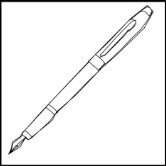
I just going to say it... I personally hate the look of the Lamy Safari and All TWSBIs.
collectorofmanythings posted a topic in Fountain & Dip Pens - First Stop
Can anyone explain to me why they like the designs so I can appreciate it more? I don’t mean to be rude or criticize people for what they like, I am just curious why you like the look of these pens. Just please reply! I really want to know what the appeal is. Thank you for your help! W. Major- 158 replies
-
- lamy
- lamy safari
-
(and 7 more)
Tagged with:
-
Hi all. Can I get some Opus 88 Demo users together please? I've had a long bad experience with these pens. Had 2 of them that leaked. You'd find the section full of ink and suddenly you have ink on your fingers in a meeting, etc. etc. At first I was looking for leaks inside the section, but I think it was something else. The feed, or the underside of the nib, would get overflow of ink, to the point where the feed collector is full. When capped this would fall into the cap and back into the section. So the main problem is overflow in the feed. I've had the pen replaced by Opus, which was nice of them, but the new pen does that, only much slower. Hold the pen downwards and, long as the rear knob is slightly open, the feed will very slowly begin to fill up. I want to ask if others are having, or can observe, similar phenomenon. I know the pen in your case may not actually drop the ink eventually, but if you can only use a light to look at the underside of your Jowo nib to see if the ink is controlled in the channel or filling up the underside, that would help me. I have a video I will add when I get a chance. Many thanks for anyone who gives me some input.
-
desaturated.thumb.gif.5cb70ef1e977aa313d11eea3616aba7d.gif)
Condition of blue Monami Penna pen I received
A Smug Dill posted a gallery image in FPN Image Albums
From the album: First look
My order of four Monami Penna pens arrived yesterday. I haven't inked any of them up yet; but my initial impression is one of disappointment. The barrel material is very prone to scratching, even from just the cardboard in the retail packaging itself. One of the pens arrived in absolutely appalling cosmetic condition, on account of movement inside the retail packaging in transit. The clear plastic display box took the brunt of the impact of being crushed and is permanently creased and deformed, along with the cardboard frame inside, but otherwise shielded the pen; however, that made for a bit more wiggle room for the pen trapped inside. p.s. I reported the issue to the AliExpress seller, and I blamed the manufacturer squarely for inappropriate retail packaging design, given that the barrel on another pen of which the box was not crushed is also marred by a haze of micro-scratches thus acquired. To the credit of the seller, he took responsibility for inadequate packaging, and offered to send me replacements for the two pens.© A Smug Dill
- 0 B
- x
-
desaturated.thumb.gif.5cb70ef1e977aa313d11eea3616aba7d.gif)
Condition of the other three Monami Penna pens I received
A Smug Dill posted a gallery image in FPN Image Albums
-
As the title says, new colours are to be introduced in the Pilot Custom 74 demonstrator line. Namely Forest Green, Blue Black and Orange Red. I saw the news on reddit Pen Gallery from Malaysia has showed a pic and is selling them https://www.instagram.com/p/CJsrqDpDhvt/ I assume these will be available everywhere where the other demos are available (except that maddeningly blue and violet seem to be US exclusives?? WHY???) It would be nice if more colours were added to the regular 74, the 91, the Elite95s, 742 and 912. That said, my wallet thinks it's best as it is and I begrudgingly agree. What would really be super exciting though is if Pilot would introduce their Stub (SU) and Waverly (WA) nibs to the 74 and 91 (pretty please, if anyone from Pilot is reading!).
- 3 replies
-
- pilot
- pilot custom 74
-
(and 1 more)
Tagged with:
-
-
- twisbi
- demonstrator
-
(and 1 more)
Tagged with:
-
I recently ordered one of these. Nice looking pen, but when it arrived there was a hairline crack along the barrel. Really fine, possibly more of a scratch. Anyhow, the seller was really great and sent a replacement - but if anything the second one has got an even worse mark on it. Is this a problem with this model or is it possible to get a clean pen?
-
The Custom 823 pens have always been highly captivating demonstrators from Pilot Corporation (Japan), sporting the second largest nib (Pilot#15, Namiki#20 nibsize), with a vacuum plunger filling mechanism. The model number 823 refers to the price and year, of launch, although in a slightly intricate manner. Since this pen was released in the year of 2000, 82 years after the company’s inception (i.e. 1918), it carries the first two digits of the model number as ‘82’ and the last digit which is ‘3’ refers to it launch price of JPY 30,000 (3 X 10,000). Also replicated the content with additional pictures in my blog, as the images are/will be reduced to a small thumbnail after a short-while by the image hosting service. Happy reading ! Below is a link to the same: The Pilot Custom 823 Amber Demonstrator Review The Custom 823 (for the Asian market) comes packaged in a standard pilot gift box (Z-CR-GN) which might not draw much attention, quite unlike the pen. The US merchandise comes with a silver sateen lined gift box with a complementary (hey! not really folks) bottle of Pilot/Namiki Ink-70 (Blue). The pen of course is a hot star. A golden label with a model number and nib specs is tagged to the clip. The box carries a user manual for a Type P fountain pen, which does mention keeping the knob slightly unscrewed (at a 2 mm distance) relative to the metal ring, while writing. http://i1302.photobucket.com/albums/ag127/soniknitr/C823/DSC_4033_zpsn5yia4uf.jpg DESIGN - THE AMBER DEMONSTRATOR (6/6) The Custom 823 comes in three standard designs of translucency transparency - Amber, Smoke and Clear resin, all with gold plated trims. The resin material seems substantial and feels heavy. A silver trimmed version may be a nice thing for many fountain pen nerds including myself. I went for an Amber one with a medium nib and find it quite challenging to resist getting another Smoke version, with recently slashed prices in Rakuten/Ebay. The Amber demonstrator given its lightness, is capable of bedazzling you even with a tiny bit of moonlight. A golden dazzle along the three bands and the clip, subtly delivers the rest. The finials at the cap along with the piston knob conclude the design with a brownish opacity. http://i1302.photobucket.com/albums/ag127/soniknitr/C823/DSC_4038_zps59uqxwrt.jpg The cap feels substantial and unscrews with one and a half turn, revealing the elegant yet simply designed pen. The grip section is moulded from the same brown resin as the cap-final and the piston-knob, and another golden ring segregates the grip from rest of the body. The amber demonstrator translucency does reveal the steel rod with a plunger seal mechanism. http://i1302.photobucket.com/albums/ag127/soniknitr/C823/DSC_4058_zpsdj6urt8a.jpg The cap does mention a few things etched across the broader of the concentric golden bands, including the model name CUSTOM 823 and PILOT MADE IN JAPAN with six stars of separations. A thinner band above renders some more aesthetics to the overall design. The clip is tension fit and it encompasses a vertically embossed PILOT within its golden sheen. http://i1302.photobucket.com/albums/ag127/soniknitr/C823/Cap_zpsp81nns3m.jpg FILLING SYSTEM (6/6) The brown piston knob unscrews from the golden ring till an end stop, post which the plunger unit can be pulled out. The rod is made of stainless steel and is resistant to most of the commonly used inks. For IG (Iron Gall) and Pigment Inks, care must be taken to clean the pen several times, to prevent clogging or deposit accumulation inside the ink passages. The pen fills to more than two-thirds its capacity, once the nib is dipped in ink and the plunger is pushed back in. This can give a quick gush of ink inside with a comfortable volume of 1.4 - 1.5 mL, which again could last for several days. Although getting some more ink into your pen is quite possible. Cleaning the pen is a similar ritual accompanied with some shake and I suggest you do it on a regular basis, for the ink stains if left may look ugly with time, and might require a light ammonia solution to go-off. And as mentioned in the manual, while writing with the pen, you would need to keep the piston-knob slightly unscrewed (at a 2 mm distance) relative to the golden ring. This will displace a conical valve seal below the piston seal to allow passage of ink to the feed. Given the high ink capacity of these pens with plunger type filling mechanism, this has been done to prevent ink-leakage. And this is a nice thing to have, if you intend to carry the 823 in a flight. http://i1302.photobucket.com/albums/ag127/soniknitr/C823/DSC_4130_zpsjqcefo3d.jpg For a rather crazy and complete fill, you do have a workaround. With the nib pointed up, you can pull out the plunger of a partially filled 823 and then by slowly pushing the plunger inside, you would get the air-gap between the inverted ink-levels and the visible end of barrel-section minimized. Once the inverted ink-level reaches the visible end of the barrel, you can submerge the nib in the ink bottle and push the plunger in. Voila! Done. This process may result in some ink escaping to the threads of the piston knob, but again you can repeat the same process with water/cleaning solution and shake a little to wash it off. NIB - ALL THAT MATTERS (6/6) The nib is friction-fit and comes in a standard 14k monotone design across three stock widths - F, M, B (and some specially ordered custom widths of FA and WA). The nib has a standard pilot design. The tail end of the nib specifies the month and year of manufacture. An elongated hexagonal imprint separates the design from the outer shoulders and tines with an arabesque decor running inside its circumference, encompassing the circular breather hole in between. The branding and nib specifications of PILOT, 14k-585 (58.5% Au Alloy) along with the nib size and width, which are imprinted below the breather hole. http://i1302.photobucket.com/albums/ag127/soniknitr/C823/DSC_4151_zpscb3t9giu.jpg A standard bluish grey plastic feed with thin fins and a decently sized feeder hole delivers the amazing ink suction. http://i1302.photobucket.com/albums/ag127/soniknitr/C823/DSC_4152_zpswsiiokoa.jpg PHYSICS OF IT (6/6) – RELATIVELY SPEAKING With a transparent translucent resin body in form of a traditional cigar shape, it does give a comfortable feel of length. The cap itself weighs 10 grams which makes it top heavy if posted. The overall weight of the 823s have thus a significant (one-third) contribution from the cap. There is then a comfortable grip section with around 1.1 cm diameter. Uncapped Length ~ 13. 2 cm Posted Length ~ 16.4 cm Nib Leverage ~ 2.4 cm Overall Weight ~ 29 g A capped and uncapped comparison with few of the standard large pens like Visconti Homo Sapiens Maxi, Pelikan m805 and MB 146 is posted below for your reference. http://i1302.photobucket.com/albums/ag127/soniknitr/C823/DSC_4154_zpsxjd20amq.jpg http://i1302.photobucket.com/albums/ag127/soniknitr/C823/DSC_4155_zpsieq78ytb.jpg ECONOMIC VALUE(6/6) It retails at around USD 288, and as usual it’s available at lower street prices towards a band of USD 200. I had got the pen at a cost of USD 220 at that time, which I thought was a good bargain. This year Rakuten sellers made it look lamentable by selling 823s at less than USD 190, inclusive of shipping! OVERALL (6/6) This 14k nib has a wet flow, albeit a hint of softness like the custom 74. The nib is springy and lays a somewhat wider line with pressure. There is no significant variation among the horizontal and vertical strokes. These wet lines take almost 15 secs to dry a Sailor Jentle Sky High on MD paper. http://i1302.photobucket.com/albums/ag127/soniknitr/C823/DSC_4180_zpsxbepmpcf.jpg Thank you for going through the review. Sonik
- 111 replies
-
- pilotcustom
- 823
-
(and 5 more)
Tagged with:
-
Hello FP wizards & Omas FP fans! I have a problem. (yeah, I know what you are thinkin ... too many pens ), but this particular issue has to do what I think is a Omas Extra 630 Demonstrator. I bought it as part of a grouping (one of two pens that induced me to buy the group of FP’s). The piston is stuck. It has traces of ink that have dried over the years. It will not budge, I gently tried to turn it. Not wanting to break or damage it I didn’t force it. I have soaked it in a tall glass bath of water and 2 squirts of liquid hand soap for 2 days. No movement. I have a choice to send back the all of the pens (which I would prefer not!), or tell the seller that it is not able to be repaired w/o professional FP fixer help and request a partial refund of the purchase price of the lot. I like the pen too much to give up that easily or to send back the lot. So, what say you? I have an Ultrasonic cleaner that I have used on other FP’s w/ success. Would you advise using this cleaner? I could simply continue to soak it, but it the water has not entered the piston chamber to dissolve the residual ink (a testament to the seal!) I am not expert at taking apart such a pen and wouldn’t risk damage to it by attempting to. Please, please let me know what you would advise! Pic’s: 1. The first was snagged off our friends Peyton Street Pens website, looks like my pen, although theirs was in pristine condition! PICS#: 2, 3 and 4 are the subject of discussion. Measurements: Capped: 5.25" or 133.35 mm ||| UnCapped: 4.34” or 110mm ||| Cap = 2.25” or 57.15mm Thank you for any comments, advise or predictions! George
- 15 replies
-
- omas
- demonstrator
-
(and 1 more)
Tagged with:
-
Omar Demonstrator Frosting After Cleaning?
boulderchips posted a topic in Fountain & Dip Pens - First Stop
Hi friends, had a quick question for any knowledgable or science-minded pen owners out there. I have an Opus 88 Omar — which I love — but when I clean it, something odd happens. The barrel, which is usually transparent, frosts over as soon as I empty the water out. Where water remains, it's perfectly clear, but it gradually fogs up entirely. I thought that it was simple condensation, but it seems to stay there for good (unless there's water present). As soon as it's not in contact with water, it frosts over. I can watch it happen. It doesn't scrub away with a q-tip or paper towel, either. I don't really mind the effect, but I was curious what caused it. Anyone else had this experience? I haven't seen this is any other demonstrator pens, but admittedly my pool isn't that large. Picture:- 12 replies
-
- demonstrator
- opus 88
-
(and 1 more)
Tagged with:
-
Probably lying for decades filled with ink, this lovely Noblesse piston was blocked and the button mechanism twisted off ! Getting it free and clean showed the next problem... a ambered, shrinked and deformated barrel. After some different trials, drilling, heating... the piston tensioning remained irregular. Or she was "pen for parts"... or we tried to revive her as a demonstrator. This is how a pen repair ended...
-
When dedication for the brand and obsession for demonstrators both are present, you eager to combine them... Buying your lath, learning, exercising, being encouraged and trained by a pen authority such as "Fountainbel", someday you reach the satisfaction of realising your dream and making your own pens, this is today ! They contain and represent all visualisation of technique, quality beauty and perfection. Creating and assembling them you understand why they are called "Meisterstück". Generation, system, size, nib... all become "clearely" visual. Maybe the combination of both would be the full perfection, telescoop with nib unit, however no must. Both are joy for the eye. Enjoy with me... Thinking over the post title, came up... Montblanc undressed, Montblanc generations... "Visualised" won and approached mostly my desire of realisation. I look very much forward to your reactions and opinions ! Kind penregards, PENRob Read more about my "penjourney", began 2018, october... https://www.fountainpennetwork.com/forum/topic/340774-making-the-demonstrators-of-my-favorite-pens/page-2?do=findComment&comment=4239401
- 27 replies
-
- montblanc
- demonstrator
-
(and 1 more)
Tagged with:
-
What is the best Demonstrator pen for a budget of under 50 dollars?
- 19 replies
-
- clear pen
- demonstrator
-
(and 4 more)
Tagged with:
-
Hi, I was thinking about buying my first TWSBI pen and I'm confused about which one I should buy. I've shortlisted the TWSBI Eco, TWSBI 580 and TWSBI Vac 700. If it were up to you, which pen would you buy and recommend?
- 22 replies
-
- twsbi
- fountain pen
- (and 8 more)
-
ASA TranNauka - JoWo 1.1 Nib The review is simultaneously posted on my blog here : Link The pen I am about to review has sold in huge nos. and probably one of the best-selling pen of ASA. There was a time when I was after Mr. Subramaniam to make a demonstrator pen with screw in nib units from JoWo/Schmidt but somehow he was not able to procure the good material which could withstand the threading to be done for those units and then we gave up. Then one fine day he informed me that he had procured a new material and will be launching an already successful Nauka in the demonstrator version (which was named TransNauka) and I was too excited for the pen and I told Mr. Subramaniam it would sell in huge nos. and therefore I convinced him that we should do a group buy for the same on FPN (TransNauka Group Buy) and believe me, it was immensely successful. ASA TranNauka – In love with Rains The group buy was so successful that he had to stop taking orders on his website for a fortnight even after the Group Buy was closed because of his limited production capability. I have already reviewed a few pens from ASA as below: ASA Rainbow : LINK ASA Viraat : LINK (Absolutely love this fat pen) ASA Spear : LINK ASA Porus : LINK ASA Patriot : LINK ASA I-Can : LINK ASA Galactic : LINK It’s been three months since I have got this TransNauka and further below is my effort to do a detailed review of the pen. Design : 4.5/05 There is an old age saying: “Beauty lies in the eye of beholder” And to my eyes, this pen is the just pure aesthetic pleasure. It’s a beauty. TransNauka inspires awe when it is inked and I believe it one-ups the already existing Nauka. It’s simple, classic, sublime and is on the lines of Bauhaus Design movement which is a unification of art, craft, and technology. The design of Nauka was inspired by famousMORA STYLOS OLDWIN CLASSIC and in fact, one of the fellow fountain pen connoisseur Prithwijit was the force behind the development of Nauka. ASA TransNauka – Uncapped The pen without cap looks like it’s just one piece as the grip section merges with the barrel in such a form that there is no step down which is generally prevalent in many pens. The pen gradually tapers towards the bottom to an almost pointed end. Similarly, the pen tapers towards the grip section till it meets the threads at the top which holds the cap. ASA TransNauka – Comparative pic when pen uncapped and capped The pen comes only in the brushed matte finish and personally prefer the brushed version better than the polished version as the polished version tends to develop micro abrasions and smudges and also looses shine over the period of time. The cap of the pen unlike the bottom of the barrel is not torpedoed shape at the top rather it is like a hemispherical dome. The pen I bought comes with chrome finish ball-end clip and it also comes sans the clip. The cap is almost 3/4th the size of pen making it a very large pen. ASA TransNauka – Cap and Barrel ASA TransNauka – Cap is 3/4th of Pen when uncapped I found the pen very minimalist with no branding. One thing I believe can be improved is to reduce the gap between the cap finial and nib unit when the pen is closed. The pen is beautiful and is bang for the buck at the price and yeah this beauty is handmade. Built & Construction : 04/05 One look at the pen and you won’t actually believe that this pen completely hand-turned. It’s almost perfectly shaped and finished from the exterior. ASA TransNauka – Lovely Finish One thing I found that as much as the exterior is well finished and shaped, the interior of the barrel was not paid much attention. There are certain undulations in interior (1 or 2 places) of the barrel which result in the formation of O-rings like shape inside the barrel with ink. I received two pens, matte brushed finish and the clear polished one. The clear polished one was all over the places with regards to finish and thus it was not launched officially. This brushed finish is superb barring one area with regards to barrel interior area. The brushed finish is also better because of the fact that it hides the lathe marks and also is not smudge-prone. The quality of material used is quite good but is brittle in nature and thus one has to be careful with regards to handling (against falls). The acrylic used is the hard non-modified PMMA and apt thickness of the material are used in pen and is quite better compared to ones used in TWSBI. ASA TransNauka – Cap View showing material thickness and finish ASA TransNauka – Material thickness in Barrel and Grip Section The pen is quality finished one which needs to be handled carefully and if proper care is taken it will last you ages. I love my TranNauka but I care for every pen that I own. If you are the one who keeps throwing his/her pen here and there then I suggest you go for the ebonite version. Balance & Size : 04/05 The cap of the pen doesn’t post securely and that’s because of the design. But.. But… But… the pen is so big even uncapped @ 135 mm that there is no need for posting. The pen is little heavy towards the nib and I believe this could have been countered by providing solid crystal end at bottom of barrel. Nevertheless, this was no issue for me, it’s a minute difference and some of you won’t even notice. ASA TransNauka – Writing with it – Unposted and Posted Initially, I had trouble adapting to the grip of the pen because of gradual slope of grip section from barrel to top of nib unit but now that I am using the pen since 3 months I have gotten used to it. The grip might also be fat for some because of the design and might not be so good for people with small hands. Now for me, it was okay because I prefer big pens with good girth. The pen is big yet light in weight but one thing I noticed is that when uncapped it is lighter than Ranga Bamboo Demonstrator but almost 4 gms heavier when capped and both are equal in length when uncapped but when capped the TransNauka is larger of the two. ASA TransNauka – Weight – Capped and Uncapped Few specification of the pen are as follows: Length of pen (closed) – 160 mmLength of pen (open and unposted) – 135 mm (including nib)Length of pen (open and posted) – 176 mmLength of Cap – 78 mmMaximum Dia of Cap – 21 mmMaximum Dia of Barrel – 14 mmDia of Barrel ( Near Barrel Bottom) – 8 mmMaximum Dia of Grip Section – 13.5 mmMinimum Dia of Grip Section – 11 mmWeight of Pen with Cap – 27.9 gms (inked)Weight of Pen without Cap – 17.13 gms (inked) Below are the pictures of the pen in comparison with others : ASA TransNauka vs Pilot Custom 823 vs ASA Patriot vs Lamy Safari – Capped ASA TransNauka vs Pilot Custom 823 vs ASA Patriot vs Lamy Safari – Uncapped As clear from above pics its a bit fat compared to others. Nib : 3.5/05 The pen can be bought in a variety of #6 sized nib options from JoWo or Schmidt and in various point widths. The one I have here is JoWo Steel 1.1 Stub nib in Black Oxide finish. ASA TranNauka - Nib Shot in Rain The nib is a screw in nib unit and easily replaceable. The nib that I got was a lemon and was scratchy out of the box. I had to tune it and now it performs the way I want. ASA TransNauka – JoW0 1.1 Nib in Black Oxide Finish ASA Nauka vs Pilot Custom 823 vs ASA Patriot vs Lamy Safari – Nib Comparison Advice to people if you are buying the pen from ASA do avail the option of pen/nib testing this might delay the pen delivery but pen and nib will be checked for writing before dispatch and yeah there are no extra charges for that. Ink Filling Mechanism: 05/05 It can take international long or shot cartridges, international converter and can be used as an ED also. The pen looks best when eye dropper-ed and I applied silicone grease to the threads before using it as ED pen. ASA TransNauka – Using as an ED Pen Ink capacity as an eye dropper is 4 ml and will vary with every pen as it is handmade one. Below are the images of handwritten review of the pen sample writing: ASA TransNauka – Handwritten Review – Page 1 ASA TransNauka – Handwritten Review – Page 2 ASA TransNauka – Handwritten Review – Page 3 ASA TransNauka – Handwritten Review – Page 4 Conclusion : 21/25 The pen was bought at group buy price of Rs. 2200 and it was a steal at that price. And now the prices have increased yet it is a value for money option. Beautiful pen but I won’t recommend this to people with small hands. What I Like: Beautiful Design Handmade Quality Finish- Exterior Good Balance and Size Good Ink Capacity Well PricedWhat I don’t Like: Internal Barrel Finish Poor OTB Nib How to Buy: The pen was bought via group buy on FPN and there will be another group buy in near future for the same. Simultaneously who don’t like waiting for group buys can buy directly from ASA website : LINK. And the last I checked it's available on pre-order only with waiting for 4 weeks. For more reviews you can check my blog here : LINK
- 21 replies
-
- asapens
- asa transnauka
-
(and 5 more)
Tagged with:








